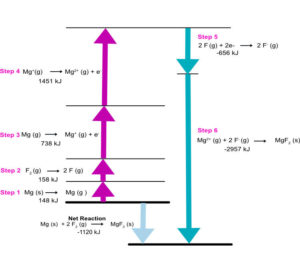Solutions/Answers to Exercises
Exercise 1. Consider the following Born-Haber cycle for MgF2. What is the lattice energy for MgF2?
The lattice energy is the reverse of Step 6.
MgF2 (s) → Mg2+ (g) + 2 F– (g)
The lattice energy is +2957 kJ.
Exercise 2. Order the following ionic compounds from lowest to highest lattice energy. MgBr2, SrBr2, CaBr2
SrBr2 < CaBr2 < MgBr2
Exercise 3. Which has the highest lattice energy, Na3P or Na2S?
Na3P
Exercise 4. Calculate the lattice energy for SrCl2. The sublimation energy for Sr is 164 kJ/mol, Ei1 = +549.5 kJ/mol, Ei2 = +1064.2 kJ/mol, Eea for Cl (g) = -348.6 kJ/mol, energy for the formation of one mole of SrCl2 from its elements = -803.7 kJ/mol, and the bond dissociation energy for Cl2 (g) = +243 kJ/mol.
The net energy change for the reaction is -803.7 kJ/mol. The lattice energy is the reverse of the formation of the solid from its ions. Once we determine the energy for the last step, we reverse the equation and change the sign for the lattice energy. First we write our equations.
Sr (s) → Sr (g)   164 kJ
Cl2 (g) → 2 Cl (g) =   +243 kJ
Sr (g) → Sr+ (g) + e–   +549.5 kJ
Sr+ (g) → Sr2+ (g) + e–   +1064.2 kJ
2 Cl (g) + 2e– → 2 Cl–   2 x (-348.6 kJ)
Sr2+ (g) + 2 Cl– (g) → SrCl2   ????
We know the net energy change is -803.7 kJ/mol. Subtract the energies from -803.7 kJ and solve for the formation of the solid from its ions–this will be x.
\( -803.7\;kJ=164\;kJ+243\;kJ+549.5\;kJ+1064.2\;kJ+2\times\;(-348.6\;kJ)\;-\;x\)
x = -2123 kJ. The lattice energy for SrCl2 is equal to +2123 kJ.
Exercise 5. Calculate the lattice energy for CaF2.
Esublimation for Ca (s) = 178.2 kJ/mol
Ei1 = +589.8 kJ/mol
Ei2 = +1145 kJ/mol
Eea = -328 kJ/mol
DF2 = +158 kJ/mol
Energy of formation for one mole of CaF2 from its elements = -1228 kJ/mol
The net energy change for the reaction is -1228 kJ/mol. The lattice energy is the reverse of the formation of the solid from its ions. Once we determine the energy for the last step, we reverse the equation and change the sign for the lattice energy. First we write our equations.
Ca (s) → Ca (g)   178.2 kJ
F2 (g) → 2 F (g) =   +158 kJ
Ca (g) → Ca+ (g) + e–   +589.8 kJ
Ca+ (g) → Ca2+ (g) + e–   +1145 kJ
2 F (g) + 2e– → 2 F–   2 x (-328 kJ)
Ca2+ (g) + 2 F– (g) → CaF2   ????
We know the net energy change is -1228 kJ/mol. Subtract the energies from -1228 kJ and solve for the formation of the solid from its ions–this will be x.
\( -1228\;kJ=178.2\;kJ+158\;kJ+589.8\;kJ+1145\;kJ+2\times\;(-328\;kJ)\;-\;x\)
x = -2643 kJ. The lattice energy for SrCl2 is equal to +2643 kJ.

